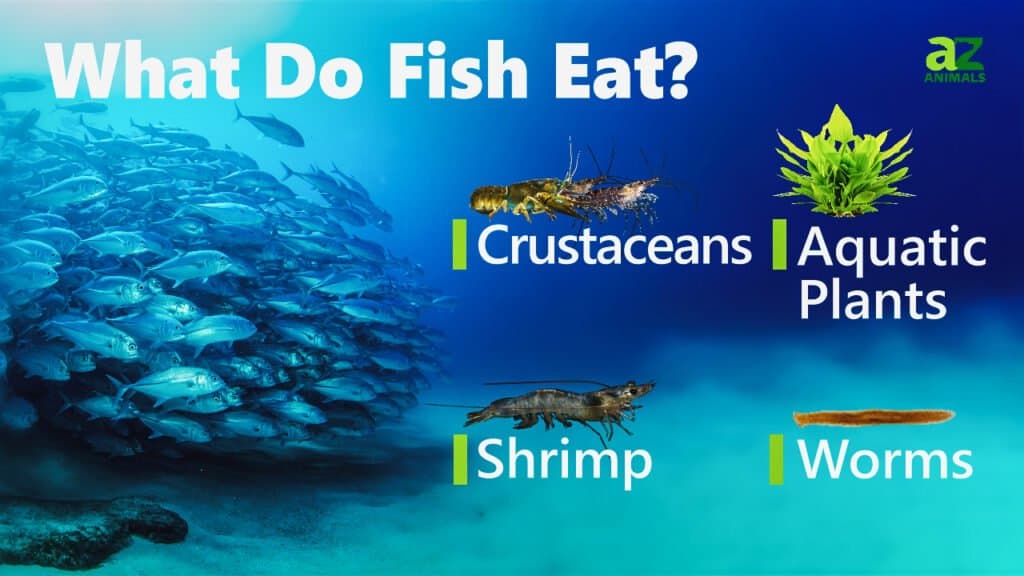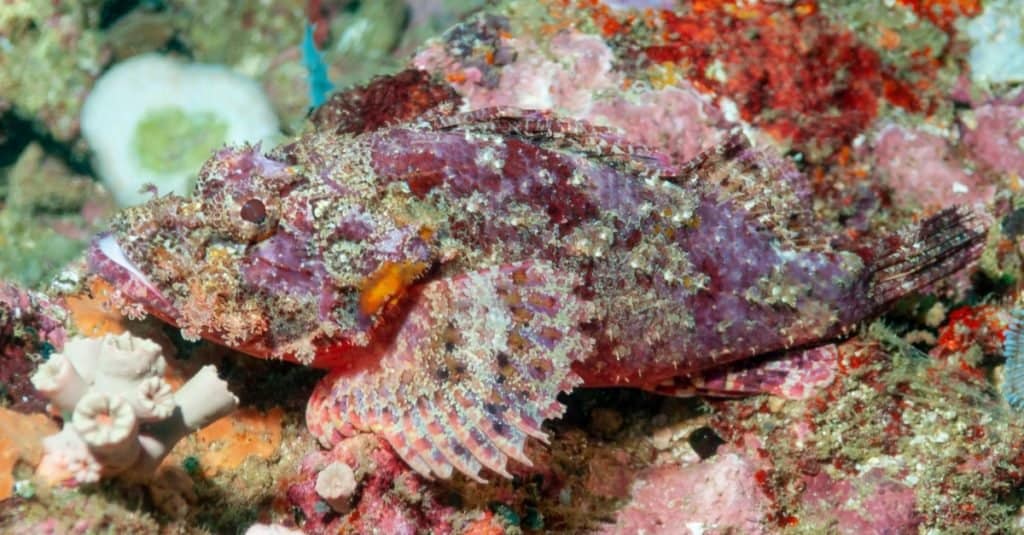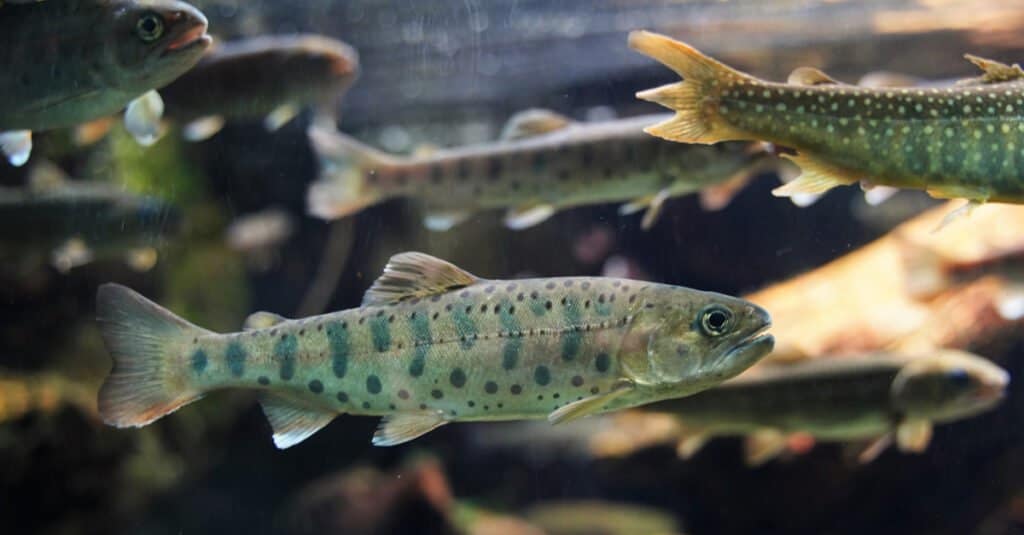
Fish rank as the most diverse group of vertebrates in the world. Scientists recognize over 34,000 distinct species, and many more are waiting to be discovered. Most fish fall into the ray-finned group of bony fish. However, other groups include cartilaginous fish and jawless fish. Fish live at every depth and in every time of marine environment, from surface feeders to bottom feeders and freshwater fish to saltwater fish. All fish possess gills that allow them to breathe and limbs without digits to help them navigate through water. Commercially, fish serve as an important food source for many populations. In addition, they are also one of the most common pets, as they are relatively easy to care for. Almost everyone can name at least one species of fish, from the goldfish to the great white shark. However, could you also answer the question concerning “what do fish eat?”
In this article, we’ll take dive deep into the diet of different types of fish. We’ll explore what common foods they like to eat, and other foods that they avoid. In addition, we’ll explore how fish hunt and forage for food. Then, we’ll take a moment to examine the particularities of the diets of pet fish. We’ll then finish with a discussion concerning what baby fish eat. With that said, let’s get ready to address the question “what do fish eat?”
What Do Fish Like to Eat?
Just as fish are extremely diverse, so are the foods that they eat. While some fish classify as carnivores, others are herbivores or omnivores. Some fish feed on small organisms, algae, or detritus, while others only go after larger prey such as other fish. Typically, the foods that a fish eats vary based upon its biology, size, and environment. That said, some larger fish, such as whale sharks, only target small foods like plankton. With this in mind, it’s important to recognize that the dietary requirements of fish will vary between species. This is why conservation is so important, and tiny changes to an environment can create a ripple effect that affects countless species. It would take too long to go through all of the different foods that fish eat in this article. Therefore, we’ve narrowed the list down to 10 foods that fish commonly eat. These foods include:
- Zooplankton
- Jellyfish
- Sponges
- Algae
- Crustaceans
- Mollusks
- Worms
- Insects
- Other fish
- Small mammals
- Small amphibians and reptiles
Overall, most fish need some meat in their diet, which they get from insects, worms, or smaller fish. Meanwhile, larger, carnivorous fish will primarily subsist on other fish, small mammals, or birds. Generally speaking, the larger the fish, the larger the prey it will target and consume. Geography also plays a major role in a fish’s diet, as some fish are limited in their choice of food.
How Do Fish Hunt and Forage For Food?

The
scorpion
fish has adapted camouflage for hunting
©Jesus Cobaleda/Shutterstock.com
Over millions of years, fish evolved highly attuned senses to help them survive and locate food. Most fish that live closer to the surface possess color vision suited for daylight. Meanwhile, deep-sea fishes adapted eyes suitable for seeing in low or no light. It’s a common belief that fish can’t hear, but this is not true. Quite the opposite, as fish have the ability to localize sounds in the water. Some species also rely on lateral lines to help them detect water motions and pressure gradients. In addition, fish use a process known as chemoreception that enables them to “smell” in water. Chemoreceptors allow fish to taste objects they touch and smell chemicals present in the water. Others, such as sharks, can determine which direction a scent is coming from and detect one part per million of blood present in seawater.
Fish use their keen senses to help them locate food, at which point they then orient themselves toward the source. Generally speaking, most fish rely on stealth and speed to catch live prey. Predatory fish will swim around until they locate a target, then sneak up on it until they’re close enough to catch it by surprise. Some fish, such as the scorpion fish, adapted camouflage which enables them to wait until unsuspecting prey swims by. Others, such as the stargazer, bury themselves in the sand and then jump out to ambush prey. Meanwhile, bottom-feeding fish typically scour the seafloor in search of detritus or left-over remains from the meals of other marine animals. Lastly, some fish, like the goatfish, will hunt in groups, and use strategies to distract, disorient, and pick off prey.
What Do Fish Eat in the Wild?

The majority of fish are omnivores
©dokosola/Shutterstock.com
In the wild, fish will eat pretty much whatever they can catch or forage. Given that the majority of fish are omnivores, they aren’t too picky about what they eat. That said, the diet of most fish consists of around 40-50% protein, with the rest made up of carbs and fats. Very few fish eat a primarily plant-based diet, although there are some exceptions. For example, parrotfish feed on coral, whereas damselfish live off of algae that eat coral. On the other hand, some fish, such as sharks, subsist almost solely on the flesh of other fish, mammals, or other creatures. Typically, fish eat whatever foods are most abundant in their environment, with the exception of fish that evolved to eat a specific food. Case in point, scale-eating fish primarily target and live off of the scales of other fish.
On average, several foods commonly appear on the list of diets for fish. For example, fish eat a variety of insects including flies, mayflies, midges, crickets, grasshoppers, and beetles. Many fish also eat worms, including superworms, mealworms, bloom worms, leeches, and nightcrawlers. Some larger fish will prey on small rats, mice, snakes, frogs, turtles, and other, smaller fish. Large predators, such as sharks, will target larger mammals such as seals or sea lions, as well as large fish and even birds. Most fish will swallow food whole, and only use their teeth to grab and hold onto prey.
What Do Pet Fish Eat?

Tetra
fish are some of the most popular pet fish
©iStock.com/Mirko_Rosenau
Pet fish have different nutritional requirements and require specialized foods to stay healthy. You should always check with your veterinarian or local pet store expert before introducing new food to your pet fish. Overall, most pet fish eat a combination of dry food, frozen food, freeze-dried food, live food, and greens. Before starting a diet for your pet gecko, always consult your veterinarian or expert at your local pet store. The most common dry foods include pellets and flakes. These foods come in different formulas depending on the nutritional needs of individual species. Meanwhile, some fish enjoy frozen or freeze-dried shrimp, prawns, krill, plankton, and worms. It’s important to note that some fish do better on a live food diet. Common live foods suitable for pet fish include ghost shrimp, crickets, worms, and feeder fish. For omnivorous fish, you can also provide lettuce, spinach, cucumbers, and other green vegetables.
What Do Baby Fish Eat?
Overall, baby fish will eat similar foods as adult fish. That said, their diets are more limited, as they cannot target larger prey. Upon hatching, baby fish typically start off eating algae, microscopic organisms, worms, tiny crustaceans, and insects. Their instincts guide them to hunt smaller prey, which may even include other young fish. As for baby pet fish, they should be fed quality baby fish food, or finely ground fish flakes. In addition, they can also eat zooplankton baby shrimp. Baby fish need to eat several times and day, and it’s important to monitor their eating habits closely. Always speak to your veterinarian or local pet store expert before introducing new foods to your baby pet fish.
Thank you for reading! Have some feedback for us? Contact the AZ Animals editorial team.








